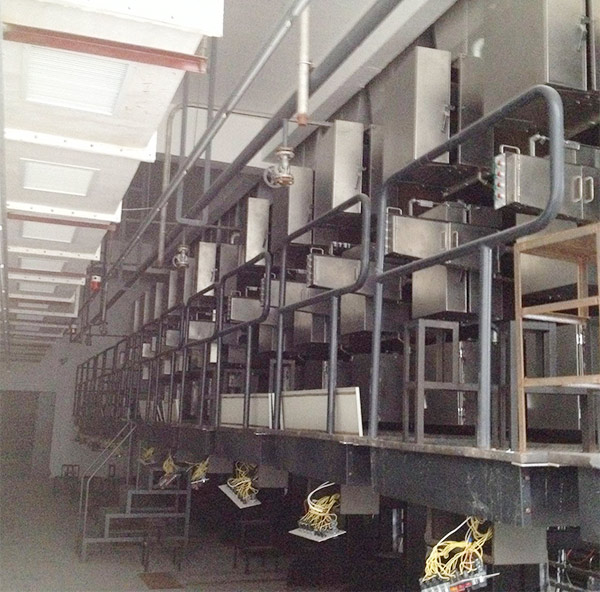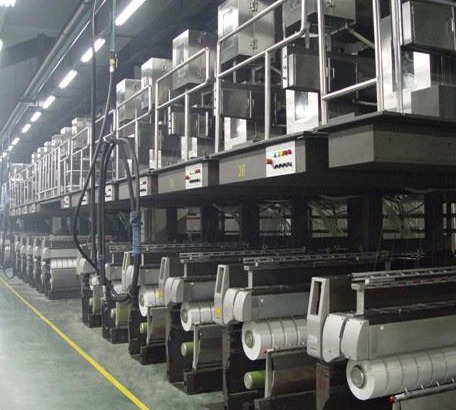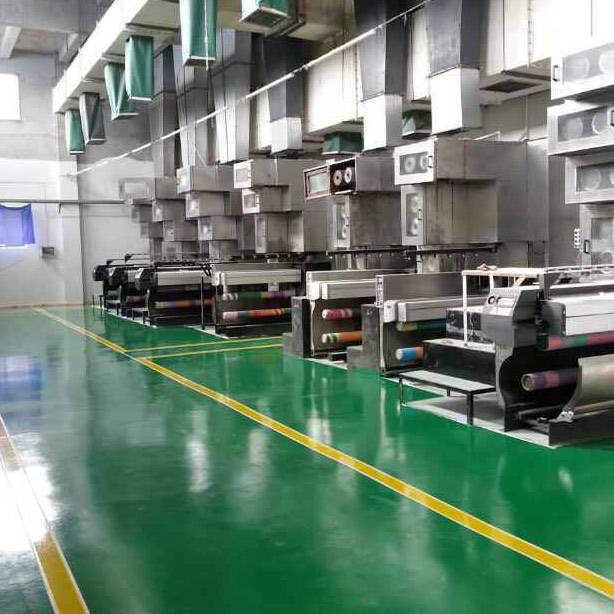- Polypropylene spinning machine
- Polypropylene FDY equipment
- Polyester POY spinning machine
- Polyamide FDY common and high strength equipment
- Polyester FDY equipment
- Polyester high strength equipment
- polyester、Polyamide、 Polypropylene BCF equipment
- Small spinning machine
- All kinds of spinning special parts
- Focus on six core modules to unlock new driving forces for the upgrading of the recycled fiber industry chain
- The China (Shishi) International Textile and Apparel Expo and the National Fashion Textile and Apparel Supply Chain Exhibition kicked off
- Argentina has lifted anti-dumping duties. The Textile Association has taken measures to break the deadlock and help foreign trade enterprises navigate the international market!
- Cotton textile industry fifteen five development guidance seminar was held in Anqing
- Explore the spinning machine: four functional areas, open the secret door of fiber production

- Contact:Mr. Huang Guofu
- Cel:0086-13901505556
- Fax:0086-519-83341119
- Email:czfb5556@126.com
- Add:No. 288-8 ChangLi Rd, Huangli Town, Changzhou, JS PRV.
During the May Day holiday, international oil prices fell sharply. Light crude for June delivery fell $3.06, or 4.27%, to settle at $68.60 a barrel on the New York Mercantile Exchange as of the close of trading on May 3. Brent crude for July delivery fell $2.99, or 3.97 per cent, to settle at $72.33 a barrel in London.
The impact of the Fed rate hike
On May 3, the US Federal Reserve Board concluded its two-day monetary policy meeting and announced that it had again raised the target range for the federal funds rate by 25 basis points to between 5% and 5.25%. This is the 10th time the Fed has raised interest rates since the current cycle began in March 2022, bringing the total to 500 basis points.
The impact of the Fed rate hike
1, polyester raw material price drop
The Fed's interest rate hike is greatly affected by the price of crude oil, which brings the fluctuation of polyester market. Under the influence of this slump, PTA and MEG have been affected to some extent. As of the May 4 close, PTA futures fell 254 points, or 4.54%.
The price fluctuation of upstream raw materials will undoubtedly bring a certain impact on polyester filament. At present, the traditional peak season has passed, and the upstream price support is not in place. The price can only be changed with the purchasing node of weaving enterprises, and then it will enter the off-season
What will happen to the market?
Many companies reported that this year's orders began to decline in the middle of April, and the situation became more obvious in May. Weaving companies also showed a decrease in production enthusiasm, and the rate of production in Jiangsu and Zhejiang regions remained at about 74.5 percent.
According to the rule of the past, foreign trade orders for autumn and winter usually start in late June, while domestic trade is in a slow season from May to August. So the expectation going forward is that foreign trade orders could pick up somewhat by mid-June and the domestic market could pick up by the end of August. Meanwhile, the market is likely to remain weak in May.
The interest rate rise will inevitably lead to the decline of raw material prices, and the market demand is not enough to support the price rise, polyester prices may decline in the short term.
Cotton market
Recently, the cotton market steadily upward, cotton yarn market prices of some varieties increased. At present cotton textile market on the supply end of 2023/24 Xinjiang cotton planting area decline and seed cotton harvest with strong expectations still support cotton prices. However, the new orders on the terminal weakened, the textile enterprises prepared goods according to demand, the purchase of raw materials was cautious, the speed of finished product inventory accumulation accelerated, but the overall position is still low. In the short term, the macro environment outside the cotton spinning market has a great impact on the cotton futures market, and the spot cotton price will run in shock. In the later stage, we need to pay attention to the cotton planting weather and the downstream demand.
What is a carbon tariff
After nearly two years of negotiations, the European Parliament has formally approved the EU's Carbon Border Regulation Mechanism (CBAM) after a vote. This means that the world's first carbon import tax will soon be in place, with the CBAM bill taking effect in 2026.
Under the influence of the global financial crisis, a new round of trade protectionism appears the rise trend, our export volume is large, deeply affected.
If Europe and the United States use climate and environmental issues to impose "carbon tariffs", China will face a new round of trade protectionism. Since there is no unified international carbon emission standard at present, once the European and American countries impose "carbon tariffs" and implement carbon standards in line with their own interests, other countries can also impose "carbon tariffs" according to their own standards, which is bound to trigger a trade war.
Carbon border regulation Mechanism (CBAM) refers to countries or regions that strictly implement carbon emission reduction policies, requiring the import (export) of high-carbon products to pay (return) corresponding taxes or carbon quotas.
Commodities covered by the CBAM include iron, steel, cement, aluminium, fertiliser, electricity, hydrogen and, under certain conditions, indirect emissions, as well as screws and bolts and downstream products such as steel products. Those who import these goods pay the difference between the carbon price in the producing country and the price of carbon allowances in the European Union's Emissions Trading system.
Will carbon tariffs be extended to textiles in the future?
The tariffs, which cover imports of steel, aluminium, cement, fertiliser, electricity and hydrogen, do not affect different industries in a uniform way. Textiles are not directly affected by the tariffs.
So will carbon tariffs be extended to textiles in the future?
This should be seen from the carbon tariff policy starting point. The reason for the tariffs is to prevent "carbon leakage" -- when EU companies shift production to countries with less stringent emissions cuts to avoid the high cost of carbon emissions within the EU. So, in theory, carbon tariffs focus only on industries that are at risk of "carbon leakage", that is, those that are "energy intensive and trade exposed" (EITE).
The Commission's official list of industries at risk of "carbon leakage" currently includes 63 economic activities or products, of which the following are related to textiles: "preparation and spinning of textile fibres", "manufacture of non-wovens and their products, except clothing", "manufacture of man-made fibres" and "finishing of textile fabrics".
In general, compared with steel, cement, ceramics, oil refining and other industries, textile is not a high-emission industry. Even if the scope of carbon tariff is expanded in the future, it will only affect fiber and fabric, and it is likely to rank behind oil refining, ceramics, paper and other industries.
The textile industry will not be directly affected, at least for the first few years of the carbon tariff. However, this does not mean that textile exports will not encounter the green barriers of the European Union. The measures being developed by the EU under the policy framework of its Circular Economy Action Plan, in particular the Sustainable and Circular Textiles Strategy, should attract the attention of the textile industry. It indicates that textile must pass a "green threshold" to enter the EU market in the future.
Declaration: This article is organized from the network, the copyright belongs to the original author;
If there is any infringement, please inform us in time and delete after verification.
Changzhou Fubon Chemical Fiber Machinery Factory Technical is a professional manufacturing supplier that develops and produces various chemical fiber machinery as its main body. It integrates scientific research, development, production and sales. In order to meet market demand, our factory has established a comprehensive chemical fiber spinning silk silk Experimental base provides customers with good equipment and technical services. We mainly provide customers with various chemical fiber sets of equipment such as polyester, Parion, nylon, aminoly, and undertake various related equipment transformation projects and custom services.
- The China (Shishi) International Textile and Apparel Expo and the National Fashion Textile
- Focus on six core modules to unlock new driving forces for the upgrading of the recycled f
- Argentina has lifted anti-dumping duties. The Textile Association has taken measures to br
- Cotton textile industry fifteen five development guidance seminar was held in Anqing
- Explore the spinning machine: four functional areas, open the secret door of fiber product
- Manager must read | say goodbye to control management, release the potential of employees,
- Empower the traditional garment industry with digital technology
- Fubon Chemical fiber Polyester industrial silk spinning and drawing machine equipment: the
- Textile information | Industry empowerment, when calligraphy meets fabric, Keqiao textile'
- High performance carbon fiber and composite material technology and equipment seminar was




